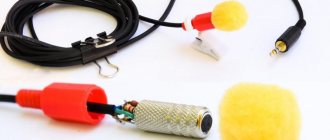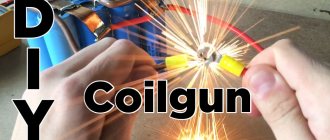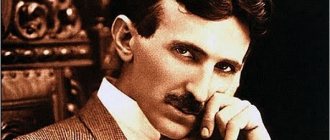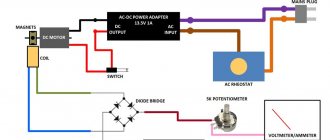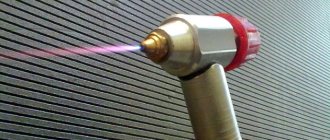Usually an electroscope is made of two strips of gold foil in a glass container, rarely available and usually not available to ordinary students. In this article I will tell you how to make an electroscope at home from scrap materials. An electroscope is an instrument that allows you to detect electrical charge, it is easy and simple to use.
Principle of operation
An electrometer is an instrument that is used to detect static electricity around objects, using the bonding effect of internal thin metal sheets due to electrostatic attraction. A static field appears on the outside of an object due to friction or load occurring.
The device is intended to determine the presence of a type of charge by transferring electrons from highly charged areas to discharged surfaces. In addition, taking into account the reaction of the plates, this makes it possible to determine the magnitude of the electrical impulse of the object. The sphere, which is located on top of the device, is the charge receiver of the subject of study.
When an electrostatically charged object approaches closer to the device, it will receive the same electrical charge from the object. That is, if you approach an object that is positively charged, the same charge will be transferred to the device.
If the electrometer already had a known electrical impulse, the following may be seen:
The metal sheets in the device must be light in weight so that their mass can balance the effects of electrical rejection forces. So, if you move the subject of study away from the device, the polarization in the plates decreases and they become in a natural position (“closed”).
Second option
You can use an electroscope not only to check the charge strength of a certain object. This equipment is also suitable for determining air ionization. That is, it can be used to test radiation. As mentioned earlier, the basic operating principle of an electroscope is based on a certain law. It’s worth adding here that if you calibrate the scale on such a device, you can accurately determine the charge strength. Some people call such things electromers.
Checking the operation of the electroscope
So we have completely figured out how to make an electroscope. Let's now test our invention. Try some simple but interesting experiments:
- Place your hand on the top of the copper wire - the petals of foil or papyrus paper should rise slightly in the air in response to this, pushing away from each other. Now you have just proven that the human body conducts an electrical charge, even a weak one.
- Now bring the electrified object closer to the wire. The simplest option would be a plastic comb used to comb your hair, a balloon or a pen rubbed on a woolen product. Pieces of foil or paper inside the device will be repelled much more noticeably, while rising up and to the sides.
- Electrify the comb even more by rubbing it, for example, on a woolen jacket. The device, by the movement of its elements, will immediately notify you of an increase in its electrical charge.
That's all we wanted to tell you about how to make an electroscope with your own hands at home or at school. Now you have a device that will correctly determine the electric charge of any item - a smartphone, clothing accessory, dishes, stationery, small household appliances, and even you and me. Its operation is very simple: you just need to bring the object of study close to the top of the electroscope.
Theoretical information
Electric charge is the ability of bodies to create an electromagnetic field. In physics, the section of electrostatics studies the interactions of charges that are stationary relative to the selected inertial reporting system.
What is it measured in?
The unit of measurement in the SI system is called “Coulomb” - this is an electric charge passing through a cross-section of a conductor of 1 Ampere in 1 second.
Letter designation – Q or q. Can take both positive and negative values. The name is named after the physicist Charles Coulomb, he derived a formula for finding the interaction forces between them, it is called “Coulomb’s Law”:
In it, q1, q2 are the charge modules, r is the distance between them, k is the proportionality coefficient.
The formula is similar to the law of attraction; in principle, it describes such an interaction. It has the least mass. Its electric charge is negative and it is equal to:
-1.6*10^(-19) Cl
A positron is the opposite value of an electron and also consists of one positive elementary charge.
In addition to the fact that it is discrete, quantized or measured in portions, the Law of Conservation of Charges is also valid for it, which says that in a closed system only charges of both signs can arise simultaneously. In simple terms, the algebraic (including signs) sum of the charges of particles and bodies in a closed (isolated) system always remains unchanged. It does not change with time or with the movement of the particle, it is constant during its lifetime. The simplest charged particles are conventionally compared to electric charges.
The law of conservation of electric charges was first confirmed by Michael Faraday in 1843. This is one of the fundamental laws of physics.
Conductors, semiconductors and dielectrics
There are many free charges in conductors. They move freely throughout the entire volume of the body. There are almost no free carriers in semiconductors, but if a little energy is transferred to the body, they are formed, as a result of which the body begins to conduct electric current, i.e. electric charges begin to move. Dielectrics are substances where the number of free carriers is minimal, so current cannot flow through them or can under certain conditions, for example, a very high voltage.
Electroscope
Rice.
1. An electroscope contains a metal rod to which a bowl is attached on one side and two strips of paper on the other. Some electroscopes are equipped with a scale. The device is designed like this. The metal rod fits vertically into the metal body (Fig. 1).
A bowl made of metal is attached to the rod on one side. The cup is located at the top of the shaft, outside the body of the electroscope.
And two thin strips of paper are attached to the other end of the rod, located inside the body.
There is a plastic plug between the rod and the body. It prevents the charge from flowing from the rod onto the body.
The case has glass windows on both sides so that you can observe the behavior of the paper strips.
Also, a scale with divisions is built into the case. It helps to evaluate the angles at which the paper strips diverge.
Some electroscopes have a simpler design (Fig. 2). In them, a rod with leaves is placed in a glass flask. A scale is not provided in such simple devices.
Rice. 2. A homemade electroscope does not contain a scale; a metal rod with strips of paper is placed in a glass flask
History of creation
The first report on the invention of the electroscope was written by the physicist and doctor William Gilbert, who worked in Great Britain during the reign of Elizabeth the First. This scientist is also the “father” of electromagnetism due to his major contributions to science in the 17th century. He created the first device in 1601 to deepen experiments with electricity.
The first device, called a versorium, was a structure in which a metal needle rotated freely on a special pedestal.
The configuration of this device was very similar to a regular compass, but it did not have a magnetized needle. Its ends were visually different from each other. In addition, one end had a negative charge, and the other had a positive charge.
The operating principle was based on impulses that arose at the ends due to electromagnetic induction. That is, taking into account which side of the needle was located as close as possible to the object, the reaction of the end was to be repelled or attracted to the object.
At the beginning of 1783, the famous Italian physicist Alessandro Volta created a condensation electrometer with increased sensitivity for determining electric charges.
But the greatest successes were achieved by the astronomer and mathematician from Germany Johann Gottlieb, who invented the gold leaf device. The design of this device resembles the design that is used today. The equipment had a glass bell with a steel sphere on top. In this case, the latter was connected by a conductor to two thin gold sheets. The plates were connected or diverged taking into account the approach of an electrically charged object.
Creating an electroscope
Now let’s look in detail at how to make an electroscope from a jar or other glass container:
- First of all, let's start with the lid or plug. Using an awl, corkscrew or thick needle, make a hole in this object so that the wire can pass through it, not loosely, but tightly.
- If the hole is too wide, then the wire must be fixed in it using tape, electrical tape, paper or plasticine.
- Stretch the wire. In this case, the smaller part of it remains outside, above the lid, and the larger part will be in the jar.
- We continue to talk about how to make an electroscope. After you have pulled the wire through the lid, bend the part that will be in the flask with a hook. You can do this with your hands, or you can use a special tool - needle nose pliers. The hook should be in a W shape.
- The wire should fit freely in this form in the container without touching its walls or bottom.
- Place foil or tissue paper on the wire hook. These elements should be placed in the lower corners of the hook, bent in the shape of a W. And they should also not touch the bottom of the jar or flask.
- Now all that remains is to tightly seal the container with a lid. Now you can start testing your own electroscope.
Charging the electroscope
The presence of electrical charging of the device is required to determine the nature of the impulse of the object under study, where the equipment is brought. If the charge of the electrometer is not first known, then it will not be possible to determine whether the load on the body is the same or opposite.
Before the equipment can be charged, it must be in a neutral state—with the same number of electrons and protons inside. Therefore, before charging, it is necessary to place the device on the floor and connect the electrometer to ground, this way you can ensure neutrality of the device’s load. Equipment can be discharged by touching it with a metal object.
There are several ways to charge the device before testing:
General information about the device
In everyday life, you can often encounter such a phenomenon as electrification. It arises as a result of certain actions with two dissimilar objects. This can be friction, pressing, winding, splitting. As a result of such actions, from a physical point of view, there is a violation of intra-atomic equality due to the redistribution of negatively charged particles - electrons.
Electrostatics is the study of the distribution of electric charges. It is believed that Thales of Miletus was the first to discover the ability of substances to interact with each other after friction. He found out that if you rub wool on amber, the latter begins to attract various small bodies, for example, pieces of paper, dust particles. At that time, the Greek philosopher could not explain the nature of the phenomenon.
In 1600, William Gilbert began studying this phenomenon and introduced the concept of “electricity.” And 63 years later, Otto von Guericke created a device with which he discovered that bodies can not only attract, but also repel. Further experiments confirmed his experiment. So, in 1733 Dufay divided electricity into two types:
- glass;
- resin
A device that allows not only to observe the interaction of elementary particles, but also to evaluate their significance, was designed by the French engineer Charles Coulomb. His meter, assembled in 1784, was quite sensitive and was called the “torsion balance.” The design of the device consisted of an insulated rod suspended on an elastic thread in a transparent closed container. A scale was marked along the diameter of the flask, and the thread was attached to the sphere. By bringing various electrified objects to the ball, the engineer determined by what amount the rod was deflected.
Coulomb's scales were subsequently improved. Instead, today they use precision electronic devices with logic chips. But before their invention, devices such as the electroscope and electrometer appeared. These are fairly simple devices, most often used in educational institutions to explain the interaction of charges.
DIY making
Making your own simple electroscope is quite simple. The required parts are easy to purchase and assembly is very quick.
Necessary materials:
First you need to cut a copper wire about 25 cm long. One end of it is bent in the shape of a spiral. It will play the role of a sphere of electrical charge receiver. This step is important because the helix facilitates the transfer of electrons from the object being studied to the electrometer due to its large area. Make a hole in the cork and thread the wire through. Make an L-shaped bend at the bottom.
Cut two foil plates into a triangle approximately 4 cm long. The main thing is that these slats are the same. Make sure they are large enough so that they do not touch the inside of the jar. The plates are attached to the wire through two previously made holes in the foil.
You need to try to make the sliding of the slats as smooth as possible. Close the jar carefully with the stopper so that the triangles are not damaged and do not spoil the assembly.
Both plates must be in contact with each other when sealing the container. If there is no connection, then you need to change the bend of the wire until the lamellas touch each other.
General information
An electroscope is needed to measure electrical charges in nearby objects. And also its use allows you to determine the polarity: positive or negative. The physical design of the device is simple; the device consists of a metal rod, which is enclosed in a glass flask.
At the ends there are two thin aluminum or gold plates, they are connected at the bottom. In this case, the structure is closed with an insulating cover, and on top of the end there is a special sphere called the “collector”.
When an electrically charged object approaches the electroscope, the lamellas located below have two reactions:
- If the lamellas move away, this means that the body has the same charge as the electrometer.
- If they connect, it means the object has an opposite charge.
Electroscopes make it possible to determine what the accumulation of electric charge is, and they indicate the sign of polarity and its intensity.
Assembly from scrap materials
It is quite difficult to invent a new type of device capable of accumulating charges. But anyone interested will probably be able to replicate the design of a simple electroscope on their own. You can assemble the meter from scrap materials that you can probably find at home.
To design it yourself you will need:
- iron wire (preferably copper);
- foil;
- scissors;
- awl;
- plasticine;
- jar with lid.
So, using an awl, you need to make a hole in the lid, the diameter of which will coincide with the thickness of the wire. Then thread the conductor through it. The length of the wire inserted should be such that it does not reach the bottom of the container. The optimal distance to the bottom of the jar is five centimeters. You need to make a hook at the end of the wire.
Now, using foil scissors, you need to cut two thin strips two centimeters long. Their purpose will be precisely to collect charges. Two strips must be threaded sequentially onto the hook. Close the jar with a lid and seal the hole near the wire with plasticine. The device is almost ready. All that remains is to twist a ball out of foil and put it on top of the protruding end of the conductor. Now you can proceed to testing the device.
The action of such an electrometer, and this self-assembled device will be called that way, is based on a natural phenomenon. It can be demonstrated as follows. Take an ebonite stick and rub it on a piece of cloth or, for example, a comb on your hair. Then touch the ball. Charges from the electrified body will transfer to the conductor (wire). Up to this point, the rod was electrically neutral. But now the charges are grouped by sign, and the wire is charged positively or negatively. Foil receives the same mark. Due to the fact that the two strips will have the same type of charge, they will repel each other.
Device modifications
After we have figured out how to make an electroscope of the simplest design, here are some recommendations for those who want to see their device more advanced:
- To increase the capacity of the electroscope, work on the upper part of the wire that rises above the lid: the easiest way is to roll it into a spiral.
- Another option for increasing the capacity: place a plastic ball wrapped in foil on the top half of the wire.
- If you have a soldering tool on hand, you can solder a small metal element to the outer piece of wire.

